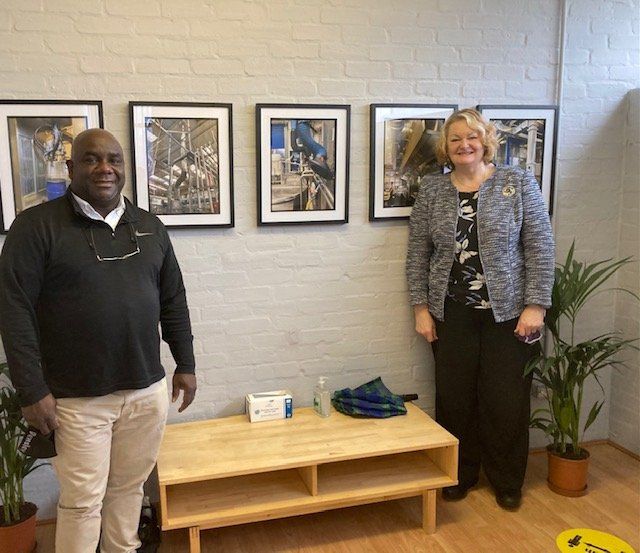CALL US 01294 203 374 | EMAIL
info@sigmaepd.com
Designed to Lead, Built to Last
Blog Layout
Give Them Confidence To Return
Densley James • Jul 15, 2020
How can you reassure them
So, it’s official. Scotland is reopening! However, after conversations with friends, colleagues and family, there seems to be a distinct lack of confidence as it relates to re-entering enclosed public places including restaurants, where the wearing of a mask would encumber our ability to engage in social activities such as eating and drinking.
The reality is, in this country, we spend most of our winter months indoors. It is also a fact that every year the National Health Service (NHS) is brought to breaking point by one virus or the other. Every year many people become ill, some more so than others. As a society, we spend millions on extra manpower, software and hardware to bolster the NHS for the next yearly wave.
‘We’ll be ready next year!’ So we tell ourselves only to discover that the goal post has moved once more - the NHS is on its knees again despite the heroic efforts of all NHS staff.
But what if we are looking at this from the wrong perspective? What if we are trying to push the brolly up from the wrong end? Could it be that infection rates are higher than necessary, giving rise to hospitalisation and death? The link between infection rates and the combination of poor air quality and patterns of air movement in enclosed public places is a point for critical focus. We can improve the health of our nation by addressing issues related to quality of air and the pattern of air movement that is served to us in public places.
A few years ago, smoking was banned in public places because of the impact of second-hand tobacco smoke on people sharing the same enclosed space. Some would remember the smell of tobacco wafting over from a smoker some distance away. Why is this important? Well, our experience of tobacco smoke gives us a tangible illustration of how very small particles can be carried in air. When subject to the same aerodynamic forces, aerosols behave in the same way as the tobacco smoke.
The thing is this. For months prominent scientists from around the world have advocated for recognition that COVID-19 can be carried by aerosols (fine spray). The World Health Organisation (WHO) recently conceded that this could be the case. Now, if COVID-19 can remain suspended in air, and lingers in the atmosphere, then it is highly likely that the other coronaviruses that threaten to decimate the NHS every year also behave in the same manner - lingering in the air that we breathe indoors.
If the above is true, and we have no reason to doubt that it is, then a better and more ‘Robust Ventilation Strategy’
needs to be put in place as part of our public health policy. We need to capture and remove this and other viruses from enclosed public spaces as an immediate response to the present threat and to future proof our society against other viruses that would threaten to undo us.
We must decide whether we want a permanent fix or are willing to endure the endless yearly cycle of sick days, ill-health and death.
Are we going to be ready with a robust response if or when the next virus or disease strikes?
As other countries reopen public places ahead of us, we can see a pattern of opening and closing emerging, as public places of different types become hot spots for the virus. It is widely accepted that going into public spaces with poor ventilation gives rise to infections. Unarguably, quality ventilation must be central to reopening safely and permanently.
There are three basic constituents of a good quality ventilation strategy:
1. Correct levels of extract
2. Correct levels of supply or make up air
3. A definitive air pattern - how the forces induced by supply and extract cause the air to move in a way that minimises human contact with the virus.
Given the trepidation that exists around the reopening of indoor public spaces, there are a couple of salient questions that need to be addressed. What can business owners do to protect and bolster the confidence of customers and staff? And, how can you reassure them that you have done everything you can to protect them?
Well, in addition to social distancing and sanitation measures, Sigma Engineering Product Design (SigmaEPD)
suggests the following:
• Implement measures such as effective ventilation that would reliably remove viruses contained in aerosol. A well-designed ventilation system is also effective in removing larger virus-carrying droplets that may settle on surfaces. Additionally, you can ensure that the air movement induced by your ventilation system leaves no regions of stagnant air, thus minimising hiding places for the virus.
• Ultraviolet Germicidal Irradiation (UVGI) and some other filtration systems can be used to kill viruses in confined spaces. These can Ideally be used in conjunction with mechanical or natural ventilation.
• Publicise the steps that you have taken to remove or kill virus particles that would otherwise linger.
Please contact Sigma Engineering Product Design Ltd (SigmaEPD) for further information on:
P : 01294203374
M : 07821256603
E : Info@sigmaepd.com
W: www.sigmaepd.com
Sigma Engineering Product Design

by Densley James
•
25 Oct, 2020
It is the simplest things in life that can have the biggest impact on the world’s greatest and most-baffling problems. But once discovered, their effectiveness and basic principles never change. In the case of the novel coronavirus, simple things like the washing of hands, the wearing of masks, and the application of the basic principles of ventilation, can capture and remove harmful substances from our breathing zone and can have an effective and lasting impact against COVID-19 and other viruses. We all hope that a vaccine will be found in the short term. However, current projections for a vaccine is the end of 2020, but in reality it may not become available for wide distribution and uptake until early to mid 2021. Further, there are questions around the rate of uptake, whether or not boosters would be required and how long immunity would last when vaccinated. The short and long response to these questions is that we do not have these answers. In reality we may not be able to eradicate this virus for some time. Some scientist estimate two years or longer. In the mean time we need to take a two-pronged approach: • Yes, we work in anticipation of a vaccine, wash our hands, keep our distance, and wear our masks. • But, we must also improve ventilation. We need to add "V" for ventilation to the governments acronym FACTS. Because, VFACT is that well designed ventilation would reduce the viral load in enclosed spaces, making it possible to reopen more safely and sustainably. Simple things first

by Densley James
•
24 Oct, 2020
The Guardian Saturday24 October 2020 Nicola Davis Science correspondent UK could be urged to keep windows open in effort to curb Covid-19 Scientists call for information campaign as evidence on role of poor ventilation mounts Britons could be urged to throw open the windows in an effort to keep coronavirus at bay as scientists call for a public information campaign to stress the importance of ventilation in reducing its spread. A paper by the Environmental and Modelling group for the government’s Scientific Advisory Group for Emergencies (Sage), dated 30 September, reveals concerns over the role of poor ventilation in the spread of the coronavirus, noting evidence that suggests insufficient airflow could increase the risk of transmission from tiny airborne particles known as aerosols that can carry the virus more than 2 metres. “Ventilation should be integral to the Covid-19 risk mitigation strategy for all multi-occupant public buildings and workplaces,” the team write. Prof Linda Bauld, an expert in public health at the University of Edinburgh, welcomed the emphasis on fresh air. “It is a really, really important topic that has not been given enough attention,” she said, noting that a number of outbreaks, including those involving choirs, have raised concerns over airborne transmission. The report urges the creation of a public information campaign on the issue. “A simple public guide on ventilation should be developed with reasons why ventilation is important, practical tips and/or FAQs,” the report notes, citing similar campaigns on the importance of handwashing and face coverings. Bauld noted that neither the UK messaging around “hands, face, space” nor the Scottish Facts campaign mention ventilation. But she added that information on ventilation would depend on the setting, meaning more complex messaging – a problem the report acknowledges. “Assessing ventilation in many environments requires engineering expertise, and mitigation measures are setting specific taking into account the nature of the building and users, ventilation type, length of exposure and activity,” the report notes.. Bauld added that in many settings, ventilation would involve a simple approach. “How are you going to get airflow in an enclosed indoor space? In most situation in the UK it is absolutely just about windows and doors,” she said. Dr Shaun Fitzgerald, from the University of Cambridge who contributed to the new report, said ventilation had been mentioned in government news meetings. But, he stressed, more needed to be done to highlight its importance, noting in his experience this was particularly necessary for smaller businesses such as convenience stores, independent coffee shops and hairdressers. “We need to raise the awareness, especially in colder weather where the natural inclination has been, for many places, which are possibly not well-designed, to close the windows and close the vents,” he said. According to the report: “Under steady state well-mixed conditions for the same duration, models suggest that exposure to aerosols approximately halves when the ventilation rate is doubled.” But while the report stresses the importance of ventilation, it says other factors must also be considered such as “thermal comfort”, exposure to pollution and energy use.
DESIGNED TO LEAD BUILT TO LAST
SIGMA Engineering Product Design Ltd
19 Macadam Place, South Newmoor Ind Est, Irvine KA11 4HP
Reg. No: 04475408
© 2024. The content on this website is owned by us and our licensors. Do not copy any content (including images) without our consent.











